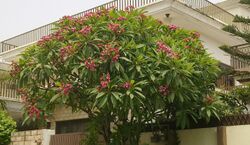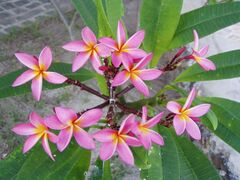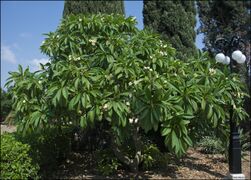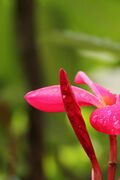Biology:Plumeria rubra
| Plumeria rubra | |
|---|---|

| |
| Tree with pink flowers in Pakistan | |
| Scientific classification | |
| Kingdom: | Plantae |
| Clade: | Tracheophytes |
| Clade: | Angiosperms |
| Clade: | Eudicots |
| Clade: | Asterids |
| Order: | Gentianales |
| Family: | Apocynaceae |
| Genus: | Plumeria |
| Species: | P. rubra
|
| Binomial name | |
| Plumeria rubra | |
| Synonyms[3] | |
|
List
| |
Plumeria rubra is a deciduous plant species belonging to the genus Plumeria.[4] Originally native to Mexico, Central America, Colombia and Venezuela, it has been widely cultivated in subtropical and tropical climates worldwide and is a popular garden and park plant, as well as being used in temples and cemeteries. It grows as a spreading tree to 7–8 m (23–26 ft) high and wide, and is flushed with fragrant flowers of shades of pink, white and yellow over the summer and autumn.
Its common names include frangipani,[2] red paucipan,[2] red-jasmine,[2] red frangipani, common frangipani, temple tree,[2] or simply plumeria. Despite its common name, the species is not a "true jasmine" and not of the genus Jasminum.
Taxonomy
Plumeria rubra was one of the many species first described by Carl Linnaeus, and appeared in the 1753 edition of Species Plantarum. Its specific epithet is derived from the Latin ruber "red". The epithets acuminata, acutifolia, and lutea are seen, but these are invalid.
Common names
The common name "frangipani" comes from the Italian Frangipani family, a sixteenth-century marquess of which invented a plumeria-scented perfume. The genus name honors Charles Plumier, who was a French monk of the Franciscan order, and a botanist.[5]
In Mexico the common name is cacaloxochitl or cacaloxuchitl. The name comes from Nahuatl and means “crow’s flower”.[6] P. rubra was declared the national flower of Nicaragua in 1971, where it is known as sacuanjoche.[7] In Spanish, frangipanis are also referred to as alhelí, alhelí cimarrón, and suche.[8] The term melia is a Hawaiian one.[9] In the Cook Islands, it is known as tipani. It is grown extensively in southern and western parts of India, where it is named champa or a derivative thereof such as chaaphaa, champige etc. It is also referred to as champa in Pakistan.[10] In Cambodia it is given the names châmpéi krahâ:m (also romanised as krahom, meaning 'red'), or châmpéi slük sruëch, while the French term for the species is frangipanier à fleurs rouges.[11] In Sri Lanka, it is known as araliya in Sinhalese. It is known by many names in Brazil, including jasmim-de-caiena, jasmin-do-pará, and jasmin-manga.[8] Another name it has in Portuguese is flor-de-Saint-Antunio.[8] In Myanmar, it is referred to as mawk-sam-ka, mawk-sam-pailong, and sonpabataing.[12] In China, it has the common name ji dan hua, and in the United States, it is referred to as nosegay.[10] In the Philippines, it is known as the kalachuchi.
Description
Plumeria rubra belongs to the dogbane family and grows as a spreading shrub or small tree to a height of 2–8 m (5–25 ft) and similar width.[5] It has a thick succulent trunk and sausage-like blunt branches covered with a thin grey bark. The branches are somewhat brittle and when broken, ooze a white latex that can be irritating to the skin and mucous membranes. This latex found in the stem of the plants is in fact toxic, but not deadly unless present in large quantities.[13] The large green leaves can reach 30 to 50 cm (12 to 20 in) long and are arranged alternately and clustered at the end of the branches. The boles of these plants can be up to 25 cm in the wild. It tends to be smaller in cultivation.[13]
They are deciduous, falling in the cooler months of the year. The flowers are terminal, appearing at the ends of branches over the summer. Often profuse and very prominent, they are strongly fragrant, and have five petals. The flowers give off their fragrance in the morning and in the evening. This fragrance is similar to that of rose, citrus, and cinnamon.[14] The colors range from the common pink to white with shades of yellow in the centre of the flower.[4][15] Initially tubular before opening out, the flowers are 5–7.5 cm (2–3 in) in diameter, and only rarely go on to produce seed - 20-60 winged seeds are contained in a 17.5 cm (7 in) pod.[9] The fruits are cylindrical pods that are rarely found in cultivation.[5]
Distribution and habitat
Its native range extends from Baja California into central Mexico south through Central America (Costa Rica, Nicaragua, Guatemala, El Salvador, Belize, Honduras, Panama) to the Department of Antioquia in Colombia and Venezuela in South America.[10] It is cultivated in the tropical regions of the world, and is perhaps naturalized in some parts of India .[2][16]
More specifically, P. rubra is cultivated in the lowlands and the Yungas in Bolivia, the coastal and Andean regions of Ecuador, and the Amazonian and Andean regions of Peru, where it inhabits disturbed areas. P. rubra has been introduced into many countries and islands, including South Africa , Yemen, Chad, and Burundi. It has been found growing everywhere in Myanmar except in very cool mountainous regions.[12] It has been introduced both in China and Pakistan and has been naturalized in the Analamanga & Betsiboka regions of Madagascar .
P. rubra generally inhabits hot and rocky areas with dry to moderate rainfall. They can survive in locations with prominent dry seasons, where they can flower on the bare branches, or in more humid conditions, where they can remain evergreen. It can also be found in rocky forests, mountain slopes, and even occasionally on plains or savannas. It occupies elevations of 500 to 1000 meters but can be found up to elevations of 1500 meters.[13]
Cultivation

The species is cultivated around the world in subtropical and tropical climates. In Australia, it is widely seen in cultivation in Sydney and Perth and warmer frost free climates northwards.[17] In the mainland United States , it tolerates USDA Hardiness zones 10B to 11 (southern coastal California and the southern tip of Florida).[15] It is also grown in Hawaii to an altitude of 2000 m.[9] They tolerate a wide variety of soils, from acid to alkaline and sandy to clay.[15] These plants grow best in dry to medium moisture, well-drained soils in full sun and will bloom through most of the year in tropical areas. They do not grow well in wet soils and in areas with temperatures below 10 °C (50 °F) during the winter seasons, the plants will stop blooming and shed their leaves.[5] Established plants are also very salt tolerant and tolerate even salt-laden winds.[13] Widely available in nurseries, frangipanis are readily propagated by cuttings of branches taken in cooler months and left to dry for a week or more.[17] As well as gardens and street- and park planting, frangipanis are planted in temples and cemeteries.[9]
Plumeria rubra is an important crop in Hawaii, with over 14 million flowers sold to be used in leis there in 2005.[18]
In temperate areas P. rubra must be grown under glass, in a large conservatory or similar, due to its requirement for warm conditions. However it may be placed outside in a sheltered sunny spot during the summer months. In the United Kingdom it has gained the Royal Horticultural Society’s Award of Garden Merit.[19][20]
Some forms in cultivation are hybrids between this species and Plumeria obtusa; these have rounded rather than pointed leaves and are less likely to be deciduous.[9] The white and yellow cultivar "Singapore" flowers all year round in Hawaii.[21]
Coleosporium plumeriae, known as plumeria rust or frangipani rust, is a fungus which attacks young leaves of P. rubra. It causes a brownish or orange powdery coating or blistering of leaves. It has been recorded from Hawaii and the east coast of Australia.[9][22] It was first recognised by the French mycologist Narcisse Théophile Patouillard on Guadeloupe Island in the eastern Caribbean in 1902, and had reached Taiwan by 2005.[23]
Uses
The USDA Forestry Service lists Plumeria rubra as a poisonous plant and warns against touching or eating any part of the plant.[24]
In Cambodia, as with other Plumeria species, P. rubra flowers is used for necklaces, as offerings to deities or as decoration for coffins. The leaves of this species are used in the care of sores and made into soothing infusions.[11] The flowers and bark of it are also used in traditional Chinese medicine in the treatment of fever, bacillary dysentery, pertussis and so on.[25] Chinese herbal teas such as Wang Lao Ji also contain P. rubra.
P. rubra possesses fulvoplumierin, an antibiotic that inhibits the growth of Mycobacterium tuberculosis. The plant has also been shown to be an antifungal, antiviral, analgesic, antispasmodic, and hypoglycemic.[13] P. rubra is also reported to contain agoniadin, plumierid, plumeric acid, cerotinic acid, and lupeol, and the stem possesses an alkaloid called triterpinoid. The plant has been known to promote digestion and excretion, along with respiratory and immune functions. The sap of the plant is used as a laxative and is a remedy for bloating and stomachaches. The bark is said to be purgative and is also used for venereal sores. The flowers can be boiled in water or juice and made into a salad to promote bowel movement, urine flow, and to control gas and phlegm. The flowers are also used in the treatment of asthma.[12]
On the Molokai island in the Hawaiian archipelago, P. rubra is cultivated in order to produce neck garlands (leis).[14] They are also used to make a scented oil in many Pacific islands that include Hawaii.[5] The flowers are used to scent coconut oil. The bark contains faint purplish streaks and the wood is hard and compact with a very fine texture. The wood takes a high polish.[13]
As a symbol
Plumeria rubra is the national flower of Nicaragua, where it is known under the local name "sacuanjoche". It is also the village flower of Asan-Maina on Guam.
Gallery
Plumeria rubra in China
References
- ↑ Botanic Gardens Conservation International (BGCI); IUCN SSC Global Tree Specialist Group (2019). "Plumeria rubra". IUCN Red List of Threatened Species 2019: e.T144270910A149056540. https://www.iucnredlist.org/species/144270910/149056540. Retrieved 18 August 2022.
- ↑ 2.0 2.1 2.2 2.3 2.4 2.5 {{citation | mode = cs1 | title = Plumeria rubra | work = Germplasm Resources Information Network (GRIN) | url = | publisher = [[Organization:Agricultural Research ServAgricultural Research Service (ARS), United States Department of Agriculture (USDA) | access-date = 2009-02-01 }}
- ↑ "Plumeria rubra L.". Board of Trustees of the Royal Botanic Gardens, Kew. 2017. http://powo.science.kew.org/taxon/urn:lsid:ipni.org:names:81275-1#synonyms.
- ↑ 4.0 4.1 "Botanica. The Illustrated AZ of over 10000 garden plants and how to cultivate them", p. 691. Könemann, 2004. ISBN:3-8331-1253-0
- ↑ 5.0 5.1 5.2 5.3 5.4 "Plumeria rubra - Plant Finder". http://www.missouribotanicalgarden.org/PlantFinder/PlantFinderDetails.aspx?kempercode=d451.
- ↑ "Biblioteca". Medicinatradicionalmexicana.unam.mx. http://www.medicinatradicionalmexicana.unam.mx/monografia.php?l=3&t=&id=7302.
- ↑ "Simbolos Nacionales". http://www.asamblea.gob.ni/simbolos-nacionales/.
- ↑ 8.0 8.1 8.2 "Taxonomy - GRIN-Global Web v 1.10.4.0". https://npgsweb.ars-grin.gov/gringlobal/taxonomydetail.aspx?id=28884.
- ↑ 9.0 9.1 9.2 9.3 9.4 9.5 Criley, Richard A (February 1998). "Ornamentals and Flowers OF-24: Plumeria". Cooperative Extension Service, C/T/A/H/R. Department of Horticulture, College of Tropical Agriculture & Human Resources, University of hawaii at Manoa. http://www.ctahr.hawaii.edu/oc/freepubs/pdf/OF-24.pdf.
- ↑ 10.0 10.1 10.2 "Tropicos | Name - Plumeria rubra L.". http://www.tropicos.org/Name/1800011.
- ↑ 11.0 11.1 Dy Phon Pauline, 2000, Plants Used In Cambodia, printed by Imprimerie Olympic, Phnom Penh.
- ↑ 12.0 12.1 12.2 "Plumeria rubra L." (in en). https://www.gbif.org/species/3169674.
- ↑ 13.0 13.1 13.2 13.3 13.4 13.5 "Plumeria rubra - Useful Tropical Plants". http://tropical.theferns.info/viewtropical.php?id=Plumeria+rubra.
- ↑ 14.0 14.1 Joulain, Daniel (2008). "Flower Scents from the Pacific" (in en). Chemistry & Biodiversity 5 (6): 896–909. doi:10.1002/cbdv.200890103. ISSN 1612-1880. PMID 18618387.
- ↑ 15.0 15.1 15.2 "Fact Sheet ST-491 Plumeria rubra Frangipani". Environmental Horticulture website. Gainesville, FL: University of Florida. October 1994. http://hort.ifas.ufl.edu/database/documents/pdf/tree_fact_sheets/pluruba.pdf.
- ↑ Rebman, J. P.; Gibson, J.; Rich, K. (2016). "Annotated checklist of the vascular plants of Baja California, Mexico". San Diego Society of Natural History 45: 39. http://sdplantatlas.org/pdffiles/BajaChecklist2016.pdf.
- ↑ 17.0 17.1 Campbell, Colin (June 3, 2006). "Fact Sheet: Frangipani". Gardening Australia Website. Australian Broadcasting Corporation. http://www.abc.net.au/gardening/stories/s1653931.htm.
- ↑ "Plumeria Rubra: An Old Ornamental, A New Crop". Actahort.org. http://www.actahort.org/members/showpdf?booknrarnr=813_23.
- ↑ "RHS Plantfinder - Plumeria rubra". https://www.rhs.org.uk/Plants/94126/Plumeria-rubra/Details.
- ↑ "AGM Plants - Ornamental". Royal Horticultural Society. July 2017. p. 80. https://www.rhs.org.uk/plants/pdfs/agm-lists/agm-ornamentals.pdf.
- ↑ Scott, Susan (1991). Plants and Animals of Hawaii. Bess Press. p. 65. ISBN 0-935848-93-2. https://books.google.com/books?id=6MvFZ1P71GQC&q=Hawaii+plumeria+%22all+year%22&pg=PA65. Retrieved 5 February 2010.
- ↑ Burke, Don (2001). "Weeds and Garden Pests: Frangipani Rust". Burke's Backyard website. Sydney, Australia: CTC Productions. http://www.burkesbackyard.com.au/2001/archives/2001_archives/in_the_garden/weeds_and_garden_pests/frangipani_rust.
- ↑ S J Roberts. "The first report of Plumeria (Frangipani) rust disease caused by Coleosporium plumeriae in Taiwan". Bspp.org.uk. http://www.bspp.org.uk/publications/new-disease-reports/ndr.php?id=011016.
- ↑ The USDA Forestry Service's Site for El Yunque National Forest.
- ↑ Plumeria rubra. "Plumeria rubra". http://www.flowersview.com/Plumeria%20rubra/Plumeria+rubra+%2883%29.jpg.html.
External links
Wikidata ☰ Q1097328 entry
 |













